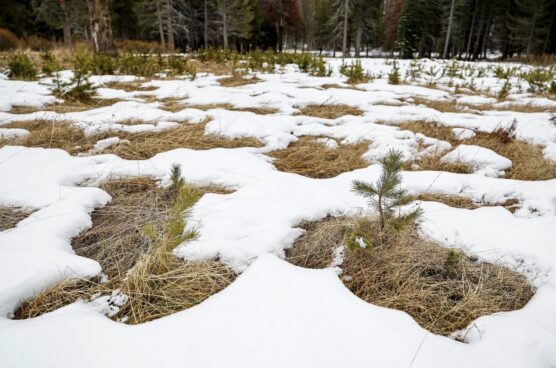By Natalie Hanson
SACRAMENTO, Calif. (CN) — The Golden State’s first test of the season’s snowpack left experts underwhelmed at the chances for another wet winter year, with California measuring well below average for rain and snowfall so far.
In a panel Tuesday, California Department of Water Resources officials reported just 7.5 inches of snow depth and a three-inch snow-water equivalent at Phillips Station near Lake Tahoe. This represents 30% of the average measurement at the location, while statewide the snowpack is at 25% of average — compared to 185% measured last year.
“What this shows us is, we’re dry,” climatologist Michael Anderson said on the panel. He said that rainfall looked promising at the start of the water year in other parts of the West, but “for most of California, it was delayed.”
The state’s water year is currently at 66% of average precipitation, with a particular drought in the southern San Joaquin Valley area.
However, Anderson added that “wild variability” is the norm in California. In nearly every year in the past decade, seasonal values are rarely within normal parameters. 2023 was “an extreme anomaly” with large amounts of rainfall bookended by months of little to nothing.
Andrew Schwartz of UC Berkeley’s Donner Summit field research station agreed that “We very rarely ever hit ‘normal’ in this state.”
Schwartz said California’s biggest investment in snow infrastructure in decades, new sky-to-stream technology installed in July 2023, is a key tool for the state to measure snowpack. He said it will also help analyze the increasing impacts of climate change, including major flooding, so the state can prepare responses.
“Our snow season is shortening,” Schwartz said. “We’re also seeing that happening throughout the season even in the coldest months.”
The department’s director Karla Nemeth said that the conditions are also affected by an ongoing El Niño period. El Niño is a naturally occurring weather phenomenon that can last several years and is associated with heat and unpredictable weather, presenting a slightly increased potential for another wet winter.
“California saw firsthand last year how historic drought conditions can quickly give way to unprecedented, dangerous flooding,” Nemeth said. “Although El Niño does not guarantee an above average water year, California is preparing for the possibility of more extreme storms while increasing our climate resilience for the next drought.”
Anderson said the early April snow survey will reveal the full picture of the snow season once the typical wet season wraps in March.
“A lot can change — we certainly saw how quickly things changed last year,” Anderson said.
He noted an anomalous system is “hanging out” in the Pacific Ocean and another cold winter storm arrived (Tuesday night). Heavy snow of 10 to 19 inches above 4,000 feet is expected in western Plumas County and Lassen Park, and on the west side of the northern Sierra Nevada mountains, through Wednesday morning. Another system is expected over the weekend, though rain and snow totals remain uncertain.
The January snow survey one year ago recorded a snow water content of 177% of average and was followed by atmospheric river storms in January and March that produced one of the largest snowpacks on record. About 3.5 million acre-feet of water was captured in state water project reservoirs. The largest, Lake Oroville, is at 130% of average capacity to date.
“While we are glad the recent storms brought a small boost to the snowpack, the dry fall and below average conditions today shows how fast water conditions can change,” the department’s snow surveys and water supply forecasting unit manager Sean de Guzman said. “It’s still far too early to say what kind of water year we will have, and it will be important for Californians to pay attention to their forecasts and conserve water, rain or shine.”
The state conducts snow surveys at Phillips Station each winter near the first of each month. The next is set for Feb. 1.
Like this:
Like Loading...
Related





 Tweet This
Tweet This Facebook
Facebook Digg This
Digg This Bookmark
Bookmark Stumble
Stumble RSS
RSS


























REAL NAMES ONLY: All posters must use their real individual or business name. This applies equally to Twitter account holders who use a nickname.
0 Comments
You can be the first one to leave a comment.